
Now SD cards exceed the speeds of CF cards (2000x) and have reached capacities of 512GB. The truth is, the card was a 512MB card with a fake label on it (for a photo shoot talking about what might come). I remember having a 4GB SD card on my desk at Lexar and everyone commenting on how amazing that capacity was. There have been many variations of SD cards over the years (capacity specs called SDHC and SDXC and speed specs like UHS-I, UHS-II and recently UHS-III) helping the technology advance in both capacities and speeds. These cards were designed with a locking tab which could be moved to turn the card into a read-only device. Secure Digital cards (more commonly called SD cards) have been around for almost 20 years and is the most common memory card format for digital cameras. I would have preferred to see a newer faster technology used. Many photographers, myself included, like the larger size of the CF cards, making them harder to lose or misplace.īut, with that said, I was not happy that Canon included a CF card slot in the newer 5D Mark IV. Both Canon and Nikon have continued making cameras with the CF card slots, mainly because of the popularity of the card and the fact that so many photographers still have a large investment in their CF cards.

Newer cards do not use this antiquated connection and use more reliable connectors. There is also the problem of particles enter the holes on the CF card connector. The CF hosts (cameras, card readers…) use pins to connect to the card and they can bend if the card is inserted incorrectly. The technology is now older and the maximum card capacity (512GB) and maximum speed (1066x) has been reached. There have been different iterations of the CF card, including Type I and Type II (which were different thickness) and even different speeds (CF 2.0, CF 3.0, CF 4.0, UDMA).Įven though this is still a current form factor, you will start to see the end of CF in the years to come. Canon and Nikon continue to announce CompactFlash (CF) based cameras and have been using CF cards in their higher-end cameras since the late 1990s. The CompactFlash card has been around for a long time (since 1994) and is still a very popular card format for DSLR cameras. Current Memory Card Formats CompactFlash (CF) The Memory Stick Micro cards were designed for smaller devices, much like the miniSD cards of today.
#Canon digital camera memory card reader pro
There were numerous types of Memory Stick formats through the 12 years, including Memory Stick PRO, Memory Stick Duo, Memory Stick PRO Duo, and Memory Stick Micro (otherwise known as M2). Sony used MemoryStick products exclusively until 2010 when they gave up on the form factor and moved most of their products to SD cards. The Memory Stick format was designed by Sony back in 1998 and used almost exclusively by them for their digital cameras, video cameras and gaming devices.

miniSD was around for a couple of years and then gave way to the more popular microSD card. miniSDīefore the advent of the microSD card, this was the memory card designed for small products (like cell phones and MP3 players). Most camera companies opted not to use MMC as their card format, although there were a few cameras which did rely on this form factor.

The format looked almost exactly like SD cards (without the locking tab), even though they were different. This memory card was very confusing from the outset.

Ultimately over time, the SD card format won the battle and xD was phased out. This card ranged from 16MB to 2GB and was designed as a competitor to the SD card format. The xD card format is another old card format and was proprietary, and only used by, Olympus and Fujifilm. These cards are long gone, but still hold a special place in my heart. It wasn’t until I visited Tokyo that I was able to find 128MB SmartMedia cards. I remember using 4MB and 16MB cards that were produced by Toshiba. Today, the larger cards would barely store one image from the current digital cameras on the market. The capacities ranged from 2MB all the way up to 128MB. The card was paper thin and rather remarkable in it’s day. The SmartMedia card goes way back, This was the first memory card I ever used in my first digital point and shoot cameras.


 0 kommentar(er)
0 kommentar(er)
